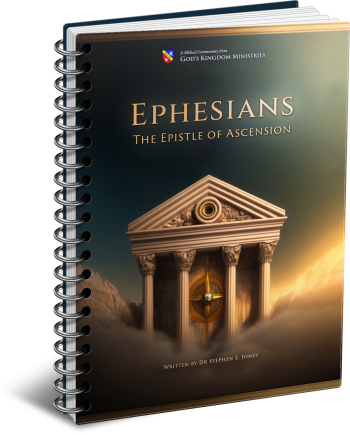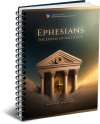Latest Posts
View the latest posts in an easy-to-read list format, with filtering options.

Paul's epistle to the Ephesians is, in some ways, a continuation of his epistle to the Romans. It enlarges upon Romans 1-8 in regard to the believer's position and right standing with God. We are "seated" with Christ, so we must "walk" according to our calling, and "stand" in the full armor of God against those who would oppose us.
Category - Bible Commentaries

In Eph. 6:13 Paul speaks of the armor of God that is needed in the struggle against the forces of darkness:
13 Therefore, take up the full armor [panoplia] of God, so that you will be able to resist in the evil day, and having done everything, to stand firm.
Jesus also mentioned this “armor” in relation to spiritual warfare in Luke 11:20-22,
20 But if I cast out demons by the finger of God, then the kingdom of God has come upon you [phthano, “preceded, anticipated, came beforehand”]. 21 When a strong man, fully armed, guards his own house, his possessions are undisturbed. 22 But when someone one stronger than he attacks him and overpowers him, he takes away from him all his armor [panoplia] on which he has relied and distributes his plunder.
Spiritual armor is thus compared to physical armor, even as demons are compared to an enemy threatening to plunder one’s house. Jesus implies that the “house” in this case is the kingdom of God and that if and when we “cast out demons, then the kingdom of God has come upon you.” Christ’s own victory in establishing the kingdom was preceded by His knowledge and use of spiritual armor. He had anticipated such spiritual warfare to ensure victory. So also is it with us, Paul says, if we “take up the full armor of God.”
We should also mention that in the food laws fish are said to be clean only if they have fins and scales. Fins signify divine guidance, and scales represent the full armor of God. The law presents this in the context of eating clean spiritual food when the word of God is presented. We believe that Paul’s epistles are part of the word of God, and that we should therefore take heed to follow his advice about spiritual armor.
Paul lists six pieces of armor that were used by Roman soldiers. Five are for defense (belt, breastplate, shoes, shield, and helmet). The sword of the Spirit is for offense.
Paul’s list begins in Eph. 6:14,
14 Stand firm therefore, having girded your loins with truth, and having put on the breastplate of righteousness.
Paul begins with the belt of truth. The importance of truth is self-evident, because a believer must believe the truth to be saved. No one yet has been saved by a lie. Hence, without this belt, one cannot have a helmet of salvation. Neither can one have a shield of faith, because faith is also based on truth. If a man believes a lie, his shield is made of paper.
Furthermore, Abrahamic faith imputes the righteousness of God to us (Rom. 4:21, 22), so without faith, how can one put on the breastplate of righteousness?
Neither can one put on the shoes of the gospel of peace without knowing truth. If one attempts to preach the gospel of peace without knowing truth, then his gospel will be warped in some manner—or even an outright lie.
Finally, one must know truth in order to wield the sword of the Spirit, which is the word of God. So Jesus prayed for His disciples in John 17:17,
17 Sanctify them in the truth; Your word is truth.
Truth is what sanctifies us. In other words, truth sets us apart for divine service. Without truth, no one is really sanctified. So Jesus continued His prayer in John 17:19, saying,
19 For their sakes I sanctify Myself, that they themselves also may be sanctified in truth.
We see, then the importance of the belt of truth and why Paul listed it first. Truth relates to all five of the other pieces of armor. No man comprehends all the truth that God has revealed in His word, because our understanding is limited and often dim. Yet the more truth we know by the revelation of the Spirit, the better will be the quality and effectiveness of our spiritual armor.
In past centuries, especially before the era of Pentecost began in 1900, Bible scholarship was based largely on soulish knowledge, rather than spiritual revelation. The mid-1800’s then saw the rise of the so-called “Higher Criticism,” where men began to critique the word of God and cast aside anything that was supernatural. They claimed to de-mythologize the Scriptures.
The Pentecostals tried to counter this movement toward soulish knowledge. This was good, but many overreacted by rejecting the study of the word. They thought that they had to choose between the two trees in the garden. Either choose life or choose the knowledge of good and evil. Truth was somehow seen as the fruit of the tree of knowledge. So it came down to a choice between truth and life, as if the two were somehow incompatible and one could have only one or the other.
The result was that over a period of time, the Pentecostal movement and its Charismatic successors shifted their focus away from the study of truth to focus on praise and worship. What started out as a reaction to dead Bible Study ended up with an inadvertent rejection of the belt of truth. Truth was subordinated to praise and worship, and so today we see churches spending far more time in praise and worship than in the study of the word itself. The result has been a frayed belt and a shortage of truth and revelation itself.
In my view, there needs to be a better balance, in order that believers may be equipped with the full armor of God that begins with the belt of truth. Truth stands whether we believe it or not. Knowledge can be soulish or spiritual, depending on the individual. Soulish knowledge is dead, but spiritual knowledge is divine revelation and is the antidote to lies. It is a revelation of truth that sanctifies us and arms us against the forces of spiritual wickedness in high places.
The Old Testament equivalent of spiritual armor is not pictured as Roman armor but is seen in the garments of the priests. The belt of truth is pictured as a sash in Lev. 8:6, 7,
6 Then Moses had Aaron and his sons come near and washed them with water [baptism]. 7 He put the tunic on him and girded him with the sash…
Moses makes no attempt to interpret this or to show its spiritual significance, but if we link it to the belt of truth in Paul’s list of spiritual armor, we have our interpretation.
The second piece of armor in Paul’s list is the breastplate of righteousness. Righteousness is not just about doing good deeds, which anyone can do, believer or unbeliever. It is the result of biblical faith, specifically Abrahamic faith. It is defined clearly in Rom. 4:3,
3 For what does the Scripture say? “Abraham believed [had faith in] God, and it was credited to him as righteousness.”
Later, in Rom. 4:21, 22 we learn another important detail. Abraham was “fully assured that what God had promised, He was able also to perform. Therefore, it was also credited to him as righteousness.” Abrahamic faith, then, is believing the promise of God to men, not the promise of men to God. This is New Covenant faith, as distinct from Old Covenant faith that is found in Exodus 19:8, where men’s promises to God were the basis of their faith.
So we see a link between the breastplate of righteousness and the shield of faith. The shield of Abrahamic faith gives us the breastplate of righteousness. Isaiah 59:17 says, “He put on righteousness like a breastplate.” Isaiah probably knew nothing of Roman armor, of course, since he prophesied about the time that Rome was just being founded (753 B.C.). Other nations equipped soldiers with armor, but not necessarily the type that the Romans used. So when Isaiah spoke of a breastplate, he was undoubtedly referring to the high priest’s breastplate, which was called the ephod (Exodus 25:7).
Lev. 8:8 says,
8 He [Moses] then placed the breastplate on him [Aaron], and in the breastplate he put the Urim and the Thummim.
Priests were called to “enter the service” (Num. 4:3), which literally can be translated “war the warfare.” They were supposed to be spiritual warriors, winning the battles in the heavens before Israel even fought their battles on the earth. Hence, their breastplate was not designed for physical warfare but for spiritual battles.
The ephod of 12 stones, one for each tribe of Israel, also had a pouch containing the Urim and Thummim, two stones (probably one white and one red) by which they inquired of God to receive yes-or-no answers. Urim means “lights” (i.e., bringing guilt to light; i.e., a verdict of guilt). Thummim means “perfections” (innocence). In any inquiry involving yes-or-no answers, if they picked the Urim stone out of the bag, it was taken as a no, and if they picked the Thummim stone, it was taken as a yes.
These stones of inquiry were put into the breastplate of righteousness, giving this piece of armor a revelatory aspect. Those who have put on the breastplate of righteousness, having true New Covenant faith, are in a position to receive answers from God and to know His will. Because the ephod was used to discover truth in a trial (as in the case of Achan in Joshua 7:16-18), it is linked to the power of discernment—judging or distinguishing between right and wrong.
Paul’s “breastplate of righteousness” covers all the major organs of the body, which, in spiritual terms, means that it is the main protection for all the organs of the body of Christ, which respond to the directions of the Head—Jesus Himself.